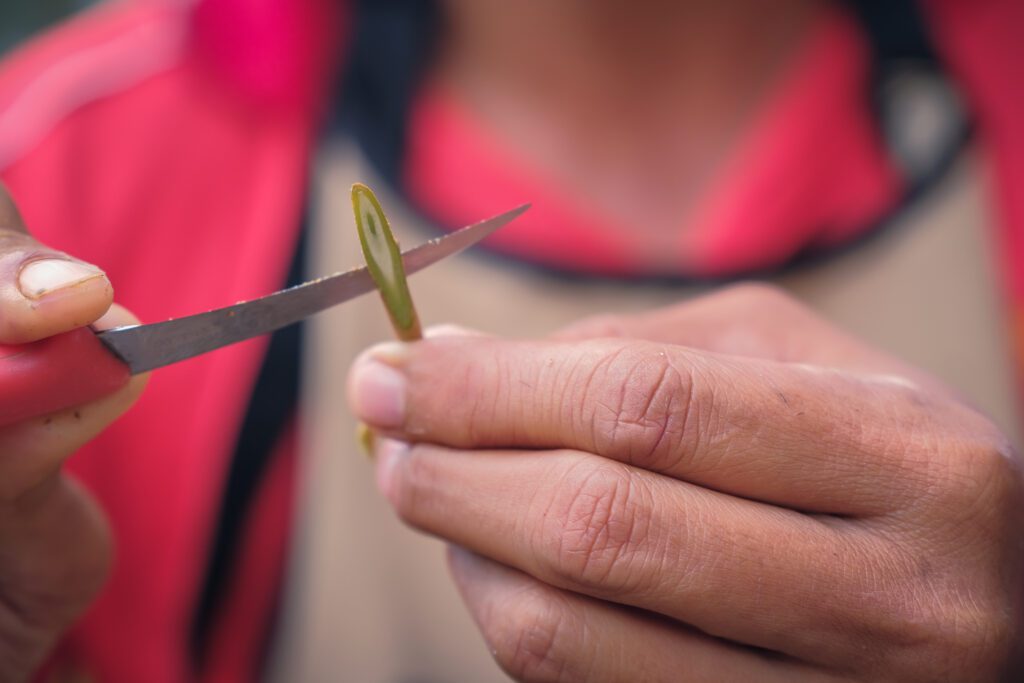Cleft grafting is a common method of propagating plants. It involves taking a scion from a desirable plant and inserting it into a stock plant. This technique is used in horticulture and agriculture to improve the growth and yield of plants. In this article, we will discuss how to do cleft grafting in 10 easy steps.
How to do Cleft Graft in 10 Steps
Cleft grafting is usually done in late winter or early spring when both the scion and the rootstock are dormant. You will need some basic tools and materials, such as a sharp knife, a saw or cleaver, grafting tape or wax, and rubber bands. You will also need to select healthy and compatible scions and rootstocks for your grafting project.
Gather your tools and materials To perform a cleft graft. Here’s a list of what you’ll need for a Cleft Graft:
- Alcohol Wipes or Soap/Water ($5)
- Grafting Knife ($16)
- Pruning Shears or Pruning Saw ($13)
- Rootstock of a Fruit Tree (Free)
- Compatible Scion Wood (about 7-inch length & 0.25-0.50-inch wide – Free)
- Parafilm or wrapping film ($7)
- Grafting Tape ($8)
- Cut Resistant Gloves ($10) Optional

Here are 10 steps to perform a successful cleft graft:
Step 1
Choose a healthy rootstock and identify a suitable branch. The branch should be at least 1 inch (2.5 cm) in diameter and have smooth bark. Use a pruning saw or sharp knife to cut off the branch where you want to insert the scion.

Step 2
Split the cut end of the branch with your knife or cleaver. The split should be about 2 to 4 inches (5 to 10 cm) deep and straight down the center. Make sure the split is clean and straight.

Step 3
Pry open the split slightly with your knife or another tool to create a gap for inserting the scion. Be careful not to widen the split too much, as this could damage the rootstock.
Step 4
Cut two scions from your desired plant variety. Each scion should have at least one bud and be about 4 to 6 inches (10 to 15 cm) long. Use a sharp grafting knife to make clean, smooth cuts.
Step 5
Trim the lower end of each scion with sloping cuts on opposite sides so that they fit snugly into the split of the rootstock. The cuts should be sloping and match the angle of the split in the rootstock. This will help the scion make good contact with the rootstock.
Step 6
Insert one scion into each half of the split so that their cut surfaces match with those of the rootstock. Make sure that their cambium layers (the thin green layer under the bark) align well for proper healing. The scion should fit snugly into the gap in the rootstock.
Step 7
Remove any excess wood from above or below the scions so that they are flush with the surface of the rootstock. Use a sharp knife to trim away any excess wood, being careful not to damage the scions.
Step 8
Wrap some grafting tape or wax around the entire grafted area to seal it from air and moisture. This will help to prevent the scions from drying out and protect them from infection. Grafting tape or wax is available from most garden centers and nurseries.

Step 9
Secure some rubber bands around both ends of the tape or wax to hold it firmly in place. This will help to keep the tape or wax in place while the scions are healing.
Step 10
Label your grafted plant with its name and date for future reference. This will help you to keep track of the different varieties of plants that you have grafted and when you grafted them.
You have now completed a cleft graft! You should keep an eye on your grafted plant for signs of growth and healing in spring and summer. You may need to remove any suckers or shoots that grow from below or above
the graft union as they may interfere with its development.
Conclusion
Cleft grafting is a simple and effective way of propagating plants. By following these 10 easy steps, you can improve the growth and yield of your plants. It is important to select healthy stock and scion plants, and to ensure that the cambium layers align when making the graft. With a little practice and patience, you can become an expert in cleft grafting and enjoy the benefits of a thriving garden or farm.

